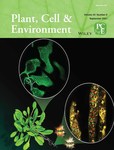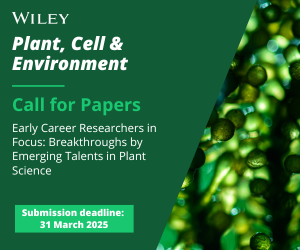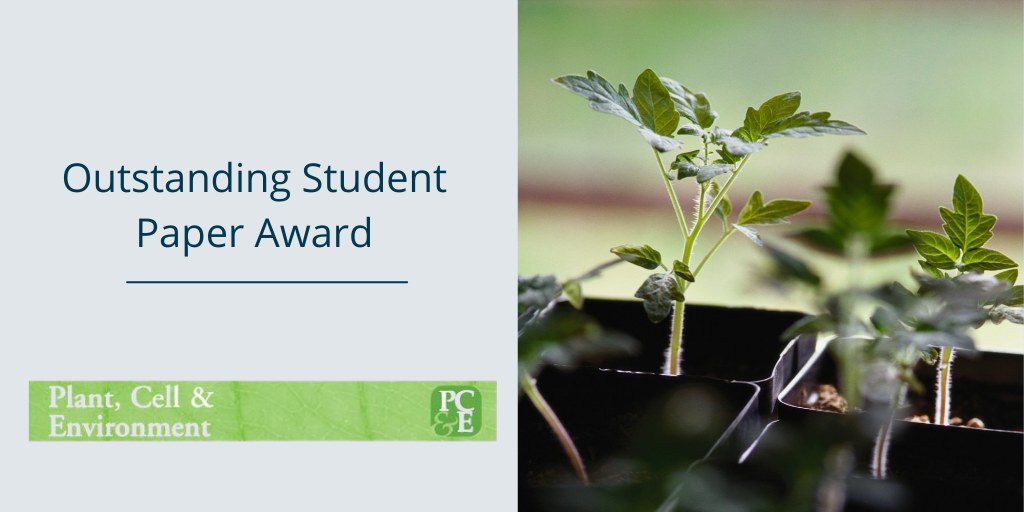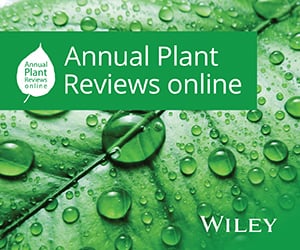Journal list menu
Export Citations
Download PDFs
COVER IMAGE
Cover Image
- First Published: 19 August 2021
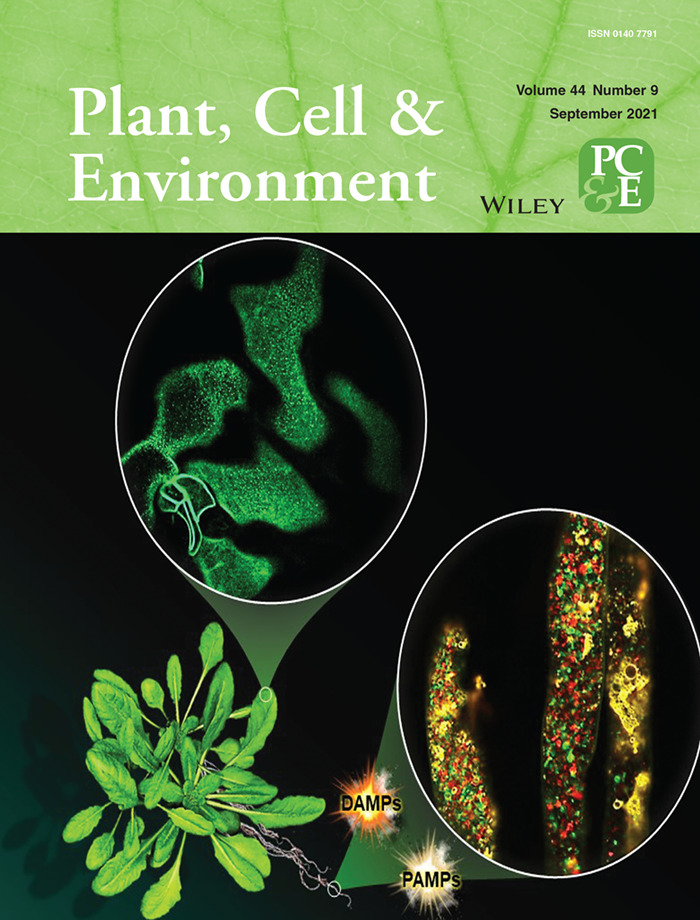
The cover image is based on the Original Article The plasma membrane–associated Ca2+ -binding protein, PCaP1, is required for oligogalacturonide and flagellin-induced priming and immunity by Moira Giovannoni et al., https://doi.org/10.1111/pce.14118.
INSIDE COVER IMAGE
Inside Cover Image
- First Published: 19 August 2021
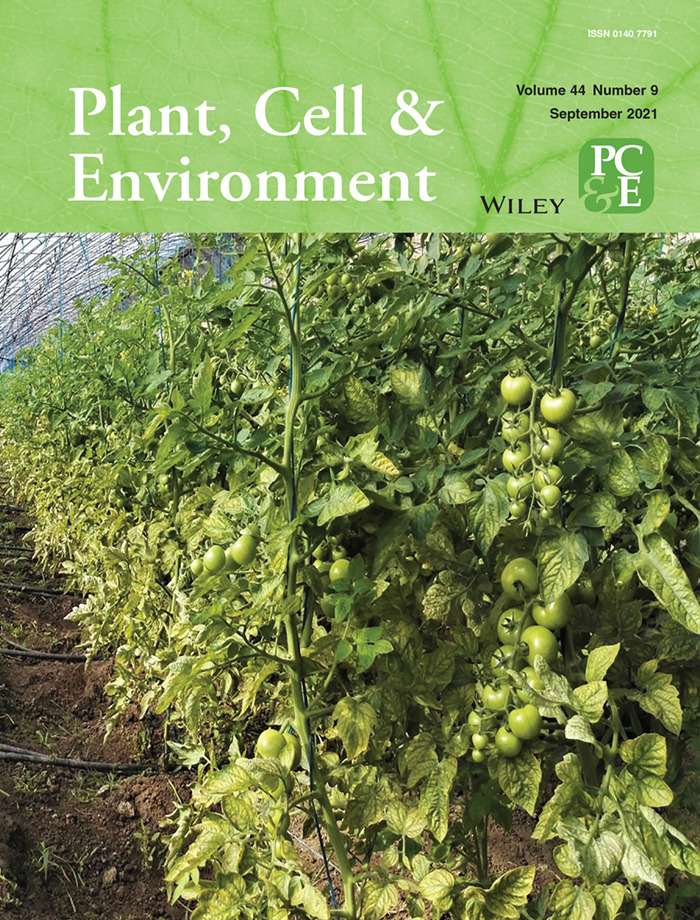
The cover image is based on the Original Article Tomato chlorosis virus–encoded p22 suppresses auxin signalling to promote infection via interference with SKP1-Cullin-F-boxTIR1 complex assembly by Sijia Liu et al., https://doi.org/10.1111/pce.14125.
BACK COVER IMAGE
Back Cover Image
- First Published: 19 August 2021
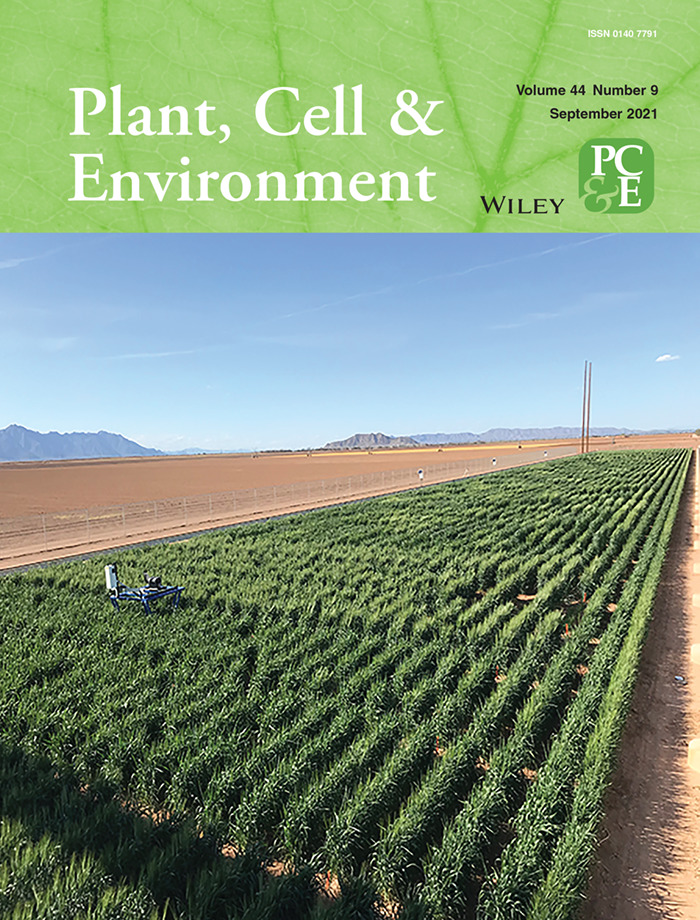
The cover image is based on the Original Article High-throughput field phenotyping reveals genetic variation in photosynthetic traits in durum wheat under drought by Nícolas Zendonadi dos Santos et al., https://doi.org/10.1111/pce.14136.
ISSUE INFORMATION
INVITED REVIEW
Evolution of a biochemical model of steady-state photosynthesis
- Pages: 2811-2837
- First Published: 19 April 2021
The year 2020 marks the 40th anniversary of the publication of the landmark model by Farquhar, von Caemmerer & Berry on photosynthesis. Here, we take a historical view on the original model, go into details of how this model has been extended since then, and review how these extensions have broadened the use of the model.
OPINION
ORIGINAL ARTICLES
The effects on isotopic composition of leaf water and transpiration of adding a gas-exchange cuvette
- Pages: 2844-2857
- First Published: 02 May 2021
The transient responses of isotopic composition of water in leaves and transpiration depends on the leaf water content and the one way flux of water vapour out of the leaves, not the net transpiration rate.
High-throughput field phenotyping reveals genetic variation in photosynthetic traits in durum wheat under drought
- Pages: 2858-2878
- First Published: 30 June 2021
Photosynthetic performance of a large durum wheat panel under progressive drought in the field was quantified using the light-induced fluorescence transient (LIFT) sensor for high-throughput phenotyping. Photosynthesis traits showed high genetic variability, aiding physiological crop breeding.
Experimental warming across a tropical forest canopy height gradient reveals minimal photosynthetic and respiratory acclimation
- Pages: 2879-2897
- First Published: 24 June 2021
Leaf-level experimental warming did not induce net photosynthetic acclimation across the canopy height gradient of two Puerto Rican tropical tree species, Guarea guidonia and Ocotea sintenisii, whereas, respiration acclimated in Guarea leaves only.
Shifting access to pools of shoot water sustains gas exchange and increases stem hydraulic safety during seasonal atmospheric drought
- Pages: 2898-2911
- First Published: 11 May 2021
Drought acclimation in the mangrove Sonneratia alba involved coordinated shifts in access to pools of water within leaves and between leaves and stems, increasing both midday assimilation rates and leaf water associated with stem hydraulic safety margins.
Cropping systems alter hydraulic traits of barley but not pea grown in mixture
- Pages: 2912-2924
- First Published: 25 March 2021
Effects of cropping systems on drought resistance of arable crops were investigated for a field-grown Pisum sativum/Hordeum vulgare mixture. Pea was less vulnerable to xylem cavitation and less stressed than barley. Cropping systems only affected xylem vulnerability of barley, but not of pea.
Foliar water uptake via cork warts in mangroves of the Sonneratia genus
- Pages: 2925-2937
- First Published: 12 June 2021
Epidermal cork warts function as a pathway of foliar water uptake in the mangroves Sonneratia alba and S. caseolaris. Leaf surface conductance to water increased with leaf rehydration duration, was inhibited in the dry season and increased with leaf dehydration.
Increased hydraulic constraints in Eucalyptus plantations fertilized with potassium
- Pages: 2938-2950
- First Published: 25 May 2021
Potassium fertilization in Eucalyptus grandis plantations reduces tree hydraulic compensation to growth through its effects on Huber value and soil-to-leaves sap flow driving force.
Rice shaker potassium channel OsAKT2 positively regulates salt tolerance and grain yield by mediating K+ redistribution
- Pages: 2951-2965
- First Published: 18 May 2021
In Oryza sativa, a Shaker K+ channel, OsAKT2 mediates K+ redistribution from shoots to roots, contributing to maintenance of Na+/K+ homeostasis and inhibition of root Na+ uptake under salt stress.
Overproduction of ABA in rootstocks alleviates salinity stress in tomato shoots
- Pages: 2966-2986
- First Published: 30 May 2021
ABA overproducing tomato rootstocks increase shoot vigour and fruit yield under saline conditions by altering stress-related responses, improving photosynthesis and optimizing source-sink relationships.
CO2 supply modulates lipid remodelling, photosynthetic and respiratory activities in Chlorella species
- Pages: 2987-3001
- First Published: 01 May 2021
High/low CO2 availability induces in Chlorella vulgaris and Chlorella sorokiniana specific cell responses as lipids remodelling, modulation of mitochondrial respiration and adaptations of the photosynthetic apparatus.
Long-term adaptation of Arabidopsis thaliana to far-red light
- Pages: 3002-3014
- First Published: 18 February 2021
The photosynthetic apparatus of plants can undergo massive changes. Arabidopsis plants acclimate to far-red light by changing the photosystems ratio and their antenna sizes. These changes are not due to dark-induced senescence but are triggered by the redox state of the electron carriers.
A poplar B-box protein PtrBBX23 modulates the accumulation of anthocyanins and proanthocyanidins in response to high light
- Pages: 3015-3033
- First Published: 10 June 2021
The BBX transcription factors PtrBBX23 promote anthocyanins and proanthocyanidins accumulation by directly regulating the expression of MYB transcription factors and structural genes in the flavonoid pathway in response to high light.
Long-term abscisic acid promotes golden2-like1 degradation through constitutive photomorphogenic 1 in a light intensity-dependent manner to suppress chloroplast development
- Pages: 3034-3048
- First Published: 15 June 2021
Here, we show that long-term ABA promotes GLK1 degradation through COP1 to suppress chloroplast development dependent on light intensity, revealing that balancing normal growth and stress response in long-term stress.
CO2-responsiveness of leaf isoprene emission: Why do species differ?
- Pages: 3049-3063
- First Published: 21 June 2021
Leaf isoprene emission rate decreases with increasing atmospheric CO2 concentration with major implications for global change. There is a significant interspecific variability in [CO2]-responsiveness of isoprene emission but the extent of this variation is unknown and its reasons are not understood. In nine isoprene-emitting species studied, we demonstrated that the [CO2]-responsiveness of isoprene emission varied an order of magnitude and that this variation was explained by interspecific variability in [CO2] effects on substrate availability and intermediate pool size supported by different species.
Production of complementary defense metabolites reflects a co-evolutionary arms race between a host plant and a mutualistic bark beetle-fungal complex
- Pages: 3064-3077
- First Published: 19 May 2021
Lodgepole pine phenotypes having different monoterpene profiles differentially affected the mountain pine beetle and its fungal symbiont, suggesting the production of complementary defense compounds in the same monoterpene mixture to target multi-species of enemy complexes, enhancing tree survival.
The plasma membrane–associated Ca2+ -binding protein, PCaP1, is required for oligogalacturonide and flagellin-induced priming and immunity
- Pages: 3078-3093
- First Published: 28 May 2021
The A. thaliana plasma membrane (PM)-anchored protein, PCaP1, is involved in elicitor-induced protection against the necrotrophic fungus B. cinerea.
(GFP)-PCaP1 organization into PM microdomains and its oligogalacturonide-induced endocytosis point to a role of PCaP1 and its turn-over in the sensing/transduction response to elicitors.
Bacillus velezensis tolerance to the induced oxidative stress in root colonization contributed by the two-component regulatory system sensor ResE
- Pages: 3094-3102
- First Published: 17 April 2021
The beneficial rhizobacterium Bacillus velezensis SQR9 or its flg22 peptides triggered oxidative burst in cucumber and Arabidopsis. The two-component regulatory system, ResDE, in B. velezensis SQR9 is involved in tolerance to plant-derived oxidative stress, thus contributing to root colonization.
Transcriptome analysis of rice response to blast fungus identified core genes involved in immunity
- Pages: 3103-3121
- First Published: 15 May 2021
In-depth time-series RNA-seq experiments revealed the full transcriptome profile in rice-blast fungus interaction, and identified core genes involved in transcriptional reprogramming in rice immune responses.
The phenylpropanoid pathway inhibitor piperonylic acid induces broad-spectrum pest and disease resistance in plants
- Pages: 3122-3139
- First Published: 30 May 2021
Perturbation of the phenylpropanoid pathway through transient chemical inhibition of the phenylpropanoid pathway enzyme CINNAMIC ACID-4-HYDROXYLASE induces broad-spectrum resistance in plants via mechanisms which include reprogramming of the phenylpropanoid and flavonoid pathways, PR protein accumulation and altered ROS metabolism.
Calmodulin-binding transcription activator AtSR1/CAMTA3 fine-tunes plant immune response by transcriptional regulation of the salicylate receptor NPR1
- Pages: 3140-3154
- First Published: 07 June 2021
Calcium signalling regulates salicylic acid (SA)-mediated immune response through calmodulin-meditated transcriptional activators, AtSRs/CAMTAs, but its mechanism is not clearly understood. Here, we report an AtSR1/CAMTA3-mediated regulatory mechanism involving the expression of the SA receptor, NPR1. These observations reveal an additional mechanism for controlling the NPR1-mediated plant immune response. A better understanding of plant immunity should help in modern agriculture. Hence, this topic is of major interest to plant scientists. The Arabidopsis thaliana lines used in this study are wild-type (WT) Columbia (Col-0) and loss-of-function atsr1 mutant (Salk_001152C).
Tomato chlorosis virus–encoded p22 suppresses auxin signalling to promote infection via interference with SKP1-Cullin-F-boxTIR1 complex assembly
- Pages: 3155-3172
- First Published: 08 June 2021
Tomato chlorosis virus–encoded p22 protein can bind to the C-terminal domain of SKP1 to interfere with the SCFTIR1 complex assembly, leading to suppressed auxin signalling and enhanced viral infection. Our findings unveil a new mechanism used by a plant virus to subvert ubiquitination to enhance infection.
Highly efficient detoxification of dinitrotoluene by transgenic switchgrass overexpressing bacterial nitroreductase
- Pages: 3173-3183
- First Published: 18 May 2021
- Overexpression of NfsI significantly improved 2,4-dinitrotoluene (DNT) uptake of switchgrass.
- More potential genetic targets for 2,4-DNT detoxification were uncovered.
Specific and multiple-target gene silencing reveals function diversity of BnaA2.NIP5;1 and BnaA3.NIP5;1 in Brassica napus
- Pages: 3184-3194
- First Published: 02 May 2021
Specific and multiple-target RNAi strategies provide novel insights into the gene functional diversification between BnaA2.NIP5;1 and BnaA3.NIP5;1 in rapeseed (Brassica napus). BnaA2.NIP5;1 is mainly expressed in the epidermis cells, which is required for efficient B uptake into roots, hence for B translocation to the shoot. BnaA3.NIP5;1 is specifically localized in the distal membrane of LRC cells to promoter root elongation under low-B conditions, which is an important seed production in the maturity stage of B. napus.




